Occupational environment monitoring at a livestock housing
99,000 ₫
Note: The above price is calculated for one sample, and the price may fluctuate depending on the area of the environment to be monitored and market movements. For more accurate pricing support, please refer to the price list or contact our consulting staff directly.
Monitoring the environment of livestock housing is a session of collecting, analyzing, and evaluating factors at the workplace that may harm workers’ health.
Table of Contents
Toggle1. Overview of Livestock Housing
a. What is livestock housing?
Livestock housing is a structure or area designed and built to raise and care for animals in the livestock industry. Livestock housing aims to provide a safe, convenient environment with suitable conditions for the growth, development, and nurturing of livestock.
The types of livestock housing are designed based on the specific animals and factors such as the number, size, and biological needs of the herd. For example, livestock housing can be used for poultry (chickens, ducks), livestock (cattle, pigs, goats), aquaculture (fish, shrimp), and other types of farmed animals.
Important factors when designing livestock housing include space, ventilation, natural light, temperature and humidity control, drainage systems, and waste management. The goal is to create a healthy, safe, and favorable environment to ensure the health and development of the animals.
Livestock housing can be constructed from materials such as wood, steel, cement, or composites and may have separate zones for feeding, resting, and breeding. Management and sanitation of the housing are also crucial to ensure a healthy living and working environment for both animals and caretakers.

b. Tasks of farmers in livestock housing
Farmers in livestock housing typically perform the following tasks:
- Animal care: Farmers must carry out daily care for the animals. This includes providing food and water, cleaning the housing, monitoring animal health, and addressing medical issues.
- Waste management: Farmers must manage waste generated from the housing, including manure, wastewater, and other waste. This involves collection, treatment, and recycling according to environmental regulations and standards.
- Feed production: Farmers may participate in producing feed for the animals. This can include planting and harvesting feed crops, preparing feed, or assisting in aquaculture feed production.
- Maintenance and repair: Farmers are responsible for maintaining and repairing facilities and equipment in the housing. This includes inspecting, maintaining, and repairing living areas, electrical systems, water systems, and other equipment.
- Organizational management: Farmers are responsible for managing and organizing activities in the housing. This includes planning, monitoring production, managing resources and finances, and overseeing daily operations.
- Implementing safety measures: Farmers must follow labor safety rules and regulations in the housing. This includes using personal protective equipment, ensuring safety when working with machinery and chemicals, and controlling potential hazards.

c. Machinery used in livestock housing
In livestock housing, various machinery and equipment are used to support animal care and housing management. Here are some common types of machinery:
- Feed production machinery: Includes grass cutters, choppers, rice threshers, corn grinders, feed mixers, bagging machines, and pelletizers.
- Water pumps: Used to supply water to animals, including well pumps, reservoir pumps, and municipal water pumps.
- Housing cleaning machines: Includes manure vacuums, trash vacuums, washing machines, and automatic cleaning systems.
- Air filtration machines: Used to control air quality in the housing, including dust filters, air purifiers, and ventilation systems.
- Animal tracking and monitoring devices: GPS devices or monitoring systems to track the location and activity of animals.
- Drying and cooling machines: Used to adjust temperature and humidity to ensure animal comfort and safety.
- Insecticide and disinfectant sprayers: Used to control insects, diseases, and harmful bacteria in the housing.
- Harvesting and processing machinery: For aquaculture, machines may be used to harvest and process aquatic products.

d. Occupational diseases for workers in livestock housing
Workers in livestock housing may suffer from certain occupational diseases related to their work. Some common occupational diseases include:
- Allergies and skin inflammation: Contact with manure, animal hair, or feed may cause skin allergies or dermatitis.
- Respiratory diseases: Inhalation of dust, ammonia fumes, or chemicals can cause pneumonia, asthma, sinusitis, and other respiratory problems.
- Spinal and musculoskeletal issues: Heavy and repetitive tasks in livestock housing can cause spinal problems, back pain, and other musculoskeletal disorders.
- Bacterial and viral infections: Contact with infected animals may cause infectious diseases such as hepatitis, diarrhea, meningitis, and other transmissible illnesses.
- Chemical-related illnesses: Exposure to cleaning agents, pesticides, and other chemicals can lead to skin, eye, respiratory, and internal organ health issues.
- Occupational accidents: During work in livestock housing, workers may experience injuries from slips, falls, or being crushed by animals or machinery.
To prevent occupational diseases, it is essential to implement labor safety measures, use personal protective equipment, and follow hygiene procedures.

e. Products in livestock housing
The main products in livestock housing depend on the type of animals raised. Some common products include:
- Meat: Produced from pigs, poultry (chickens, ducks, geese), cattle, goats, sheep, and other animals.
- Milk: Produced from livestock such as cows, goats, and sheep.
- Eggs: Produced by poultry such as chickens, ducks, and geese.
- Leather and fur: Harvested from animals such as pigs, cows, goats, and sheep to produce leather, fur, and related products.
- Fertilizer: Organic fertilizer from animal manure can be collected, processed, and used for crops and garden plants.
- Animal feed: Housing can produce and provide feed such as mixed feed, grains, hay, seeds, and other products to nourish animals.
Other by-products may include agricultural by-products from farm gardens and specially processed products depending on the type of livestock and farm production plans.

2. Overview of Occupational Environmental Monitoring Services
a. What is occupational environmental monitoring in livestock housing?
Occupational environmental monitoring (or workplace environment measurement) in livestock housing is the activity of collecting, evaluating, and analyzing environmental parameters within the housing to implement timely measures, minimize health hazards, and prevent occupational diseases. Workplace environmental monitoring is mandatory for all livestock housing.
Occupational environmental monitoring is crucial in protecting and improving worker health because employees are the main resource of a business and directly generate profits. Workers exposed to risk factors exceeding permissible levels may suffer health impacts and occupational diseases.
REGISTER FOR OCCUPATIONAL ENVIRONMENT MONITORING SERVICE
b. Nam Viet’s occupational environmental monitoring program
Nam Viet’s occupational environmental monitoring program is designed by engineers specializing in labor safety and environmental protection. With the aim of ensuring worker health and safety, the program uses modern measurement methods to monitor air quality, water, microclimate, physical factors, dust, and other workplace conditions. This program is essential for maintaining a safe working environment and protecting employee health.
Additionally, Nam Viet’s program plays an important role in researching and developing new solutions to improve workplace environmental quality. With the dedication and professionalism of the monitoring experts, Nam Viet’s exclusive monitoring program is a breakthrough in labor safety management and environmental protection in Vietnam.

c. Standardization in workplace measurement procedures
Standardization in Nam Viet’s measurement procedures is essential to ensure accuracy and reliability of results. The program follows recognized standards and procedures set by the Ho Chi Minh City Department of Health. This ensures high reliability of data used in evaluating workplace conditions and making decisions to improve the work environment and protect employee health.
Standardized procedures also ensure that measurements are conducted by highly qualified monitoring specialists with extensive experience, allowing managers and experts to trust Nam Viet’s results and make precise, valuable decisions for workplace health and environmental protection.
By applying standardized measurement procedures, Nam Viet demonstrates its commitment to providing a safe working environment and protecting employee health, while contributing to the advancement of labor safety and environmental management in Vietnam.
d. Reporting livestock housing monitoring results
Workplace environmental monitoring results are compiled according to Form No. 04, Appendix III, issued with Decree 44/2016/ND-CP and are prepared in two copies: one sent to the contracting workplace and one retained by the monitoring organization.
The retention period of monitoring results is unlimited according to legal regulations.

e. Frequency of occupational environmental monitoring according to the law
According to Clause 2 of Article 18 of the Law on Occupational Safety and Health 84/2015/QH13, employers must organize workplace environmental monitoring to evaluate harmful factors at least once a year.
f. Deadline for submitting occupational environmental monitoring reports
The deadline is before December 31 each year. Enterprises in production facilities are required to submit monitoring reports to the local Department of Health where their main office and employees are located.
Whenever there are changes in technology, production processes, or upgrades that may introduce new hazardous factors, enterprises must update occupational health records with relevant environmental monitoring data.
g. Penalties for violations of occupational environmental monitoring regulations
According to Article 27 of Decree No. 12/2022/ND-CP dated January 17, 2022, on administrative penalties in labor, social insurance, and overseas contracted workers:
- Clause 2: A fine of 2,000,000 – 5,000,000 VND for employers who fail to publicly disclose monitoring results at the workplace immediately after results are obtained.
- Clause 3: A fine of 20,000,000 – 40,000,000 VND for employers who fail to conduct environmental monitoring to control health hazards as required by law.
- Clause 4: A fine of 40,000,000 – 60,000,000 VND for employers who collude with monitoring organizations to commit fraud in environmental monitoring but have not yet reached criminal liability.
3. Harmful Environmental Factors for Workers in Livestock Housing
Workers in livestock housing may be exposed to various harmful environmental factors. The following are some potential environmental hazards in livestock housing:
- Dust and fumes: In livestock housing, dust and fumes may arise from animal waste, feed, waste mixtures, and other substances. Dust and fumes can irritate and negatively affect workers’ respiratory system and eyes.
- Pollutants from animal waste: Animal waste in livestock housing contains pollutants such as bacteria, viruses, debris, and toxic gases. Exposure to these substances may cause infections, inflammation, and other health issues.
- Chemicals: In some cases, workers in livestock housing may come into contact with chemicals such as pesticides, antibiotics, disinfectants, and water treatment substances. Improper use or exposure can be hazardous to health.
- Noise: Livestock housing may have noise from machinery, equipment, and animal sounds. Continuous and high-intensity noise can cause stress, sleep disturbance, and negatively affect workers’ nervous system.
- Temperature and humidity: The environment in livestock housing may have high temperature and humidity, especially in areas where animals are kept.
REGISTER FOR OCCUPATIONAL ENVIRONMENT MONITORING SERVICE
4. Measures to Improve Working Conditions in Livestock Housing
To improve the working environment in livestock housing and protect workers’ health, the following measures can be applied:
- Dust and fume management: Ensure livestock housing is regularly cleaned, dust and waste are removed to reduce exposure. Use efficient ventilation and dust extraction systems to maintain clean and safe air.
- Ensure ventilation and air circulation: Improve ventilation systems to maintain airflow and reduce harmful substances. Properly adjust temperature and humidity control systems to create a safe and comfortable working environment.
- Personal protective equipment: Ensure workers properly use protective equipment such as masks, goggles, gloves, and protective clothing to prevent direct contact with pollutants and protect respiratory and skin health.
- Training and education: Train workers on safe working procedures, environmental protection regulations, and proper use of protective equipment. Raise awareness about potential hazards and preventive measures in the workplace.
- Noise control: Apply measures to reduce noise in livestock housing such as acoustic barriers, ear protection, or noise-reducing equipment. Limit prolonged use of noisy machinery and provide sufficient rest for workers.
- Periodically conduct occupational environment monitoring in the facility to collect and analyze harmful factors affecting workers, then implement adjustments to reduce risks and prevent occupational diseases.
5. Benefits of Regular Monitoring of Livestock Housing
An Toan Nam Viet provides businesses with great benefits when using occupational environment monitoring services as regulated by Decree 44/2016/ND-CP on management and control of harmful factors in the workplace affecting workers.
- Businesses can proactively control harmful factors in workshops or factories.
- Receive consultation and recommendations on measures to reduce harmful factors and improve the quality of the working environment.
- Indirectly protect human resources, a key factor in business development.
- Reduce the impact of occupational diseases on workers’ health, lowering future treatment costs.
- Improve workers’ health, which contributes to better product quality and consistent production output.
- Comply with labor safety regulations and avoid legal risks.
- Enhance reputation and professionalism in every aspect, thereby elevating the business’s brand.
The occupational environment monitoring service of Nam Viet is a solution to reduce the impact of occupational diseases, contributing to a healthy and high-quality working environment.

6. National Occupational Environment Monitoring Center
Nam Viet Occupational Environment Monitoring Center is a professional unit in supervising and measuring workplace environmental quality throughout all provinces in Vietnam. With an experienced team of monitoring specialists, the center uses modern measurement devices to ensure accuracy and reliability.
In addition to providing monitoring services, the center also assists clients in planning, handling, and tracking workplace environmental issues. Following the motto “customer-centered,” the center prioritizes customer satisfaction, meets all needs, and commits to providing the best solutions for businesses.
REGISTER FOR OCCUPATIONAL ENVIRONMENT MONITORING SERVICE
With investments in technology, equipment, and workforce, Nam Viet’s monitoring center has become one of the most reputable units in occupational environment monitoring in Ho Chi Minh City with the following objectives:
- We always value brand reputation and the quality of our services.
- We provide customers with the best and most appropriate solutions possible.
- Alongside a team of experienced Masters and Engineers, we aim to protect the environment and benefit businesses.
- Working with Nam Viet Environmental Monitoring, companies will receive professional service from experts and the best cost advantages.
The occupational environment monitoring process at Nam Viet includes the following basic steps:
- Before monitoring, the company ensures all equipment is calibrated and compliant with legal regulations.
- Carry out the monitoring process fully and correctly as committed to the Department of Health.
- Accurately report monitoring results to employers.
- If results indicate unsafe conditions, Nam Viet provides corrective solutions, and the facility will implement them as follows:
- Implement measures to improve working conditions to minimize harmful effects and prevent occupational diseases.
- Organize health checkups to detect occupational diseases and related conditions early for workers in unsafe positions.
- Provide material support to workers according to labor law regulations.

7. Pricing for Occupational Environment Monitoring
To help businesses carry out occupational environment monitoring professionally and effectively, Nam Viet provides clients with a detailed and reasonable price list for monitoring services.
- The price list provides detailed information about the costs of monitoring services, including transportation, measurement, analysis, and reporting fees. Clients can trust the accuracy and reliability of the reports.
- We always offer competitive and reasonable prices and are ready to answer any inquiries about monitoring services quickly and professionally.
- With Nam Viet’s price list, clients can easily select service packages that suit their needs. We commit to delivering maximum satisfaction with professional service quality.
No comments yet

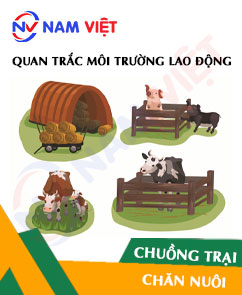
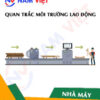
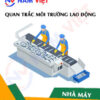

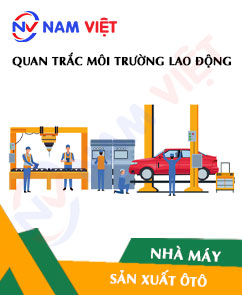


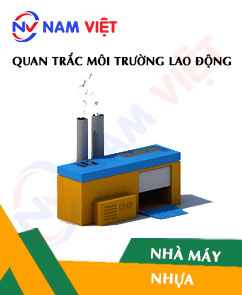
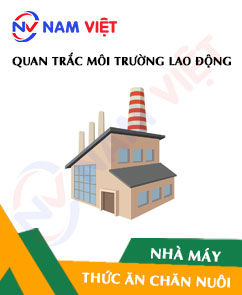

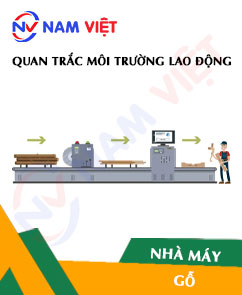
Review Occupational environment monitoring at a livestock housing
There are no reviews yet.